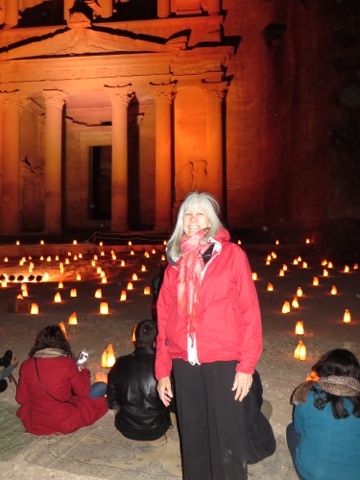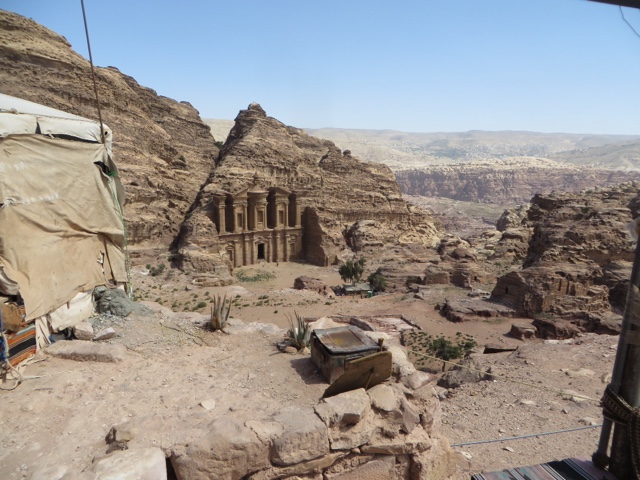The ancient city of Petra is more than 2000 years old and prospered during the Nabataean Empire from 1st century BC through the trade in frankincense, myrrh, and spices. Petra was later annexed by the Roman Empire and thrived until a large earthquake in 363 AD destroyed the city. In 1812 a Swiss explorer named Johannes Burckhardt set out to rediscover Petra. He dressed up as an Arab and convinced the Bedouins to take him to the lost city. Petra, know as the rose-red city from the color of the rock, became known in the West as a fascinating and beautiful ancient city.
We were fortunate to arrive on a day that they have night tours into the Treasury. We bought our tickets at the visitor center and waited until 8:30 to start our walk into the park.
They said close your eyes and when we opened them this was what we saw. Pretty magical.
Barb made our hotel reservations and we stayed in the Petra guest house at the entrance to the Archaeological Park. A very nice hotel with a good restaurant, outdoor patio, and the Cave Bar.
This is the modern town at night.
No, it is not snowing, although it was cold. This is my camera picking up the dust in the air as we walked along the candlelit trail to the Treasury.
This is the most recognized structure in Petra, the Treasury or Al Khazna.
Yes, it was chilly.
Lynn, Barb, and Ellen
March 10 we had a quick breakfast at the hotel and then headed into the canyon at 8. We wanted to walk but there were plenty of carriages, horses, camels, mules, and donkeys ready to help transport the tourist.
Bab Al Siq is the gateway into the city. Bab is Arabic for gateway and Siq is the gorge. The gorge resulted from natural splitting of the mountain. It is just over a kilometer long and reveals the vividly colored geology of the area. This was the candlelit area we walked the night before.
Two rock carved water channels run along both sides. As well as a dramatic entrance into Petra, the Siq also holds many relics from Petra's past, including a paved road, carvings in the walls, and scared stones.
Lynn and Bobbie posing with carriage in the Siq.
Carved water ways and carvings on the walls.
The light at the end of the tunnel.
Leads to Al Khazna, the Treasury. This is Petra's most magnificent facade and rises to almost 40 meters high. The Treasury is intricately decorated with Corinthian capitals, decorative bands, figures and more, and it is crowned by a funerary urn, which according to local legend conceals a pharaophs treasure. The treasury is believed to be the mausoleum of the Nabataean King Aretas IV (9 BC - 40 AD).
The group- Bobbi, Barb, Lynn, Ellen, me.
There were a lot of tourist and opportunities for them to spend their money.
The Rock is beautiful and there are carvings into the rock everywhere you look.
This is the theatre and it is carved into the side of the mountain and can accommodate 4000.
Bobbi at the theater.
This is the Street of Facades due to the many carvings of tombs on each side.
The Royal Tombs is the name given to the four magnificent adjoining facades. These tombs are the Urn, Silk, Corinthian, and Palace.
Not much inside of the tombs.
We walked over to the excavation of the Petra church. It was built in the 5th century AD and thought to be destroyed the following year by fire or earthquake.
The qualities of the floor mosaics attest to the church's significance.
This is the baptismal pool at the church.
The Great Temple is one of the major monuments of central Petra. Today sheep were crossing the main courtyard.
There were a lot of beautiful goats and sheep in the canyon.
Our challenge of the day was to walk to the Monastery or Ad-Dayr. Rumor was it was 1000 steps up.
Just to think these people that live close by walk this everyday. This lady was selling souvenirs close to the end of the walk. Bobbi and Lynn are taking a break.
It took me 45 minutes.
Here is our reward. This is one of the largest monuments in Petra measuring 47 meters wide by 51 meters high. The Monastery dates to the early second century AD. The interior is occupied by two side benches and an altar. The hall was later re-used as a Christian chapel and crosses were carved in the rear wall, which is how the structure got its name.
We did a little more climbing to see the view from the top of the mountain.
The Monastery from the scenic viewpoint.
We walked down from the Monastery and stopped at our final two structures. This is Qasr Al-Bint, a square monument, that was the main temple and still stands 23 meters high. The temple dates to the first half of the first century AD.
The Great Temple complex comprises an entryway, a lower temenos, and upper, temenos, and the temple itself. A temenos is a holy area in front of a temple for worshippers since only priests were allowed into the temple. The columns plus the entablature they carried would place the original temple height at 18 meters high.
Inside was a small theater .
We walked out of the canyon around 3:30. Went out to eat and ordered 4 plates to split with the five of us.














































No comments:
Post a Comment